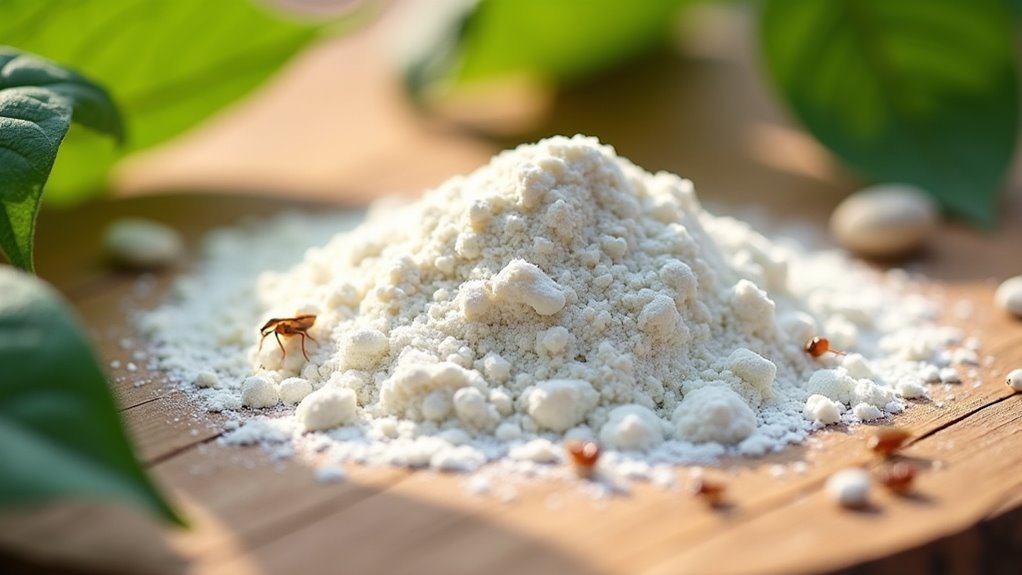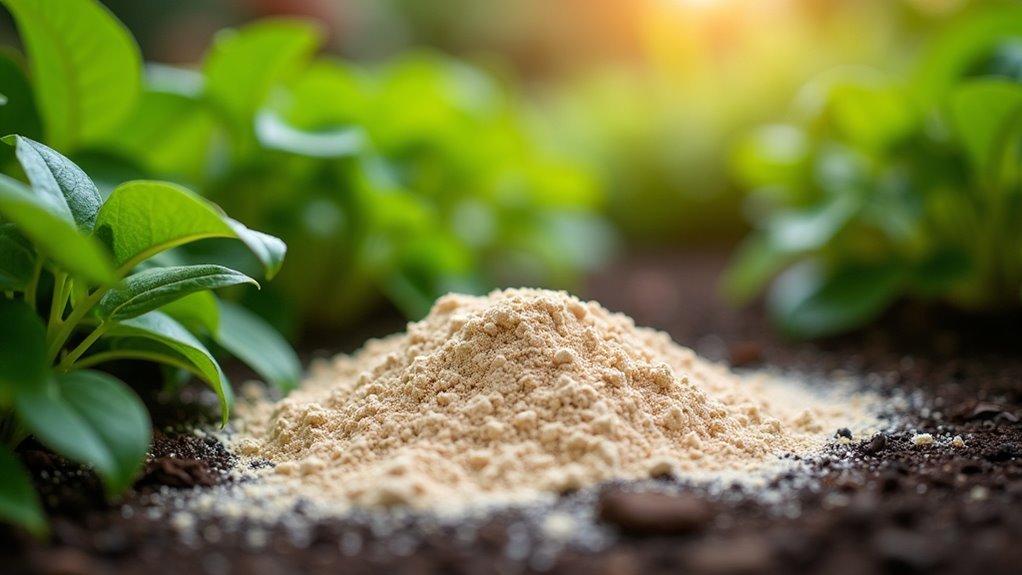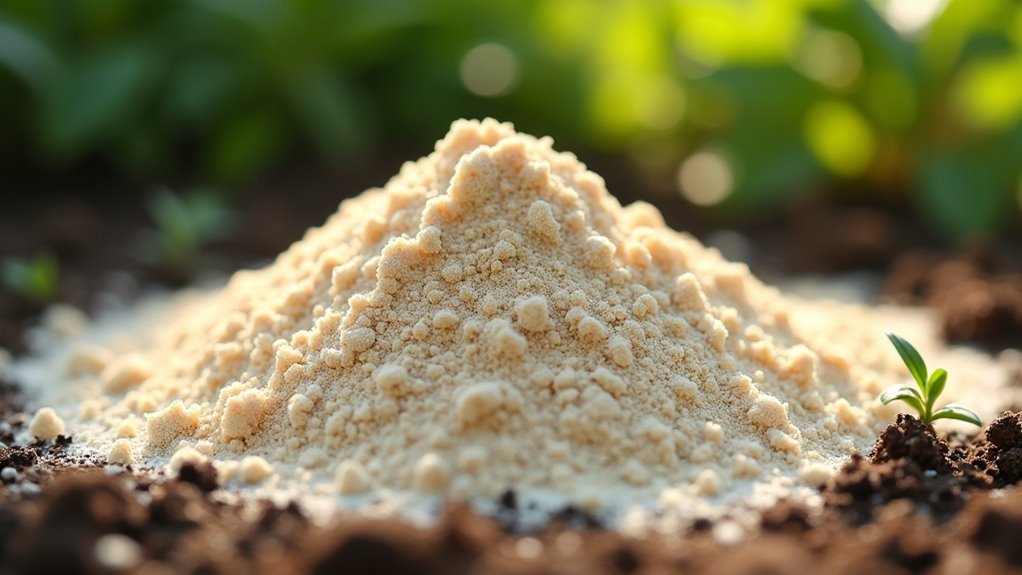You can use diatomaceous earth preventatively by applying thin layers around entry points like doors, windows, and foundation cracks, plus high-moisture areas such as kitchens and bathrooms. Dust garden beds to deter aphids and beetles, and treat pet areas for flea prevention. This food-grade powder damages insects’ exoskeletons and absorbs moisture they need for survival. Reapply every 8-10 days or after rainfall, and you’ll discover additional strategic techniques for maximizing its protective effectiveness.
Understanding How Diatomaceous Earth Prevents Pest Infestations

When you’re dealing with persistent pest problems, diatomaceous earth offers a proactive solution that works by disrupting insects’ natural processes before they can establish themselves in your space.
This preventative measure creates an effective barrier that absorbs moisture critical for insect survival while damaging their exoskeleton upon contact.
When you apply diatomaceous earth around entry points like doorways and windowsills, you’ll deter ants, cockroaches, and fleas from invading your home.
Food-grade DE works similarly in gardens, where it forms a protective layer against aphids and beetles.
Food-grade diatomaceous earth creates an effective protective barrier in garden beds, safeguarding plants from destructive aphids and beetle infestations naturally.
The microscopic particles cut through insects’ outer shells, causing dehydration and death.
This dual-action approach helps prevent infestations before they become established, making DE an invaluable tool against garden pests and household invaders.
Key Areas to Apply Diatomaceous Earth for Maximum Prevention
Since strategic placement determines diatomaceous earth’s effectiveness, you’ll want to focus on specific high-traffic areas where pests commonly enter and establish themselves.
Apply diatomaceous earth around entry points like doors, windows, and foundation cracks to create protective barriers. Target high-moisture areas including kitchens and bathrooms, paying special attention to corners and crevices where cockroaches and silverfish hide.
For thorough preventative pest applications, dust your garden beds to deter ants, aphids, and slugs while creating healthier growing environments.
Establish a pest-free zone by treating pet sleeping areas and food dishes to combat fleas and ticks.
Remember to regularly reapply diatomaceous earth after rain or cleaning sessions, as moisture reduces its pest control properties. This strategic approach guarantees maximum prevention throughout your property.
Proper Application Techniques for Long-Term Pest Deterrence

Beyond knowing where to apply diatomaceous earth, mastering the proper application techniques guarantees you’ll achieve lasting pest control results.
Use a light dusting method to create a thin layer rather than heavy applications, as this maximizes insect contact while preventing pests from maneuvering around barriers. Focus on high-traffic areas where insects commonly travel for maximum exposure.
Apply diatomaceous earth in thin, light layers across insect pathways to maximize contact and prevent pests from avoiding treated areas.
You’ll need to reapply after rainfall or when moisture compromises the desiccant properties. Monitor areas regularly and replenish every 8-10 days to maintain continuous protection.
Incorporate diatomaceous earth into your integrated pest management strategy alongside sealing entry points and maintaining cleanliness. This thorough approach guarantees long-term pest deterrence and helps prevent pest infestations effectively.
Safety Considerations When Using Food-Grade Diatomaceous Earth
When you’re applying food-grade diatomaceous earth for pest control, you’ll need to take specific precautions to protect yourself and others from potential respiratory and skin irritation.
While this natural product is generally safe, proper handling techniques can prevent unnecessary exposure to fine dust particles that may cause discomfort.
Understanding both the application safety measures and the broader health implications will help you use diatomaceous earth effectively while minimizing any risks to your household and environment.
Proper Application Precautions
Although food-grade diatomaceous earth offers a natural pest control solution, you’ll need to take specific safety precautions to protect yourself and your family during application. Always wear a dust mask to prevent fine particles from irritating your respiratory system, and work only in well-ventilated areas.
| Safety Equipment | Application Area | Maintenance |
|---|---|---|
| Wear dust mask/respirator | Use well-ventilated spaces | Monitor treated areas regularly |
| Use protective eyewear | Keep pets/children away | Reapply diatomaceous earth after rain |
| Wear gloves for protection | Apply when dry conditions exist | Store in cool, dry location |
| Avoid skin irritation | Wait for dust to settle | Check for moisture damage |
These proper application precautions guarantee diatomaceous earth remains effective while protecting everyone’s health during pest control treatments.
Health and Environmental Impact
Food-grade diatomaceous earth presents minimal health risks when you handle it correctly, but understanding its safety profile helps you make informed decisions about pest control in your home.
This biodegradable substance offers effective pest control solutions while maintaining environmental responsibility. However, its abrasive nature requires careful consideration.
Key safety guidelines include:
- Wear protective masks during application to prevent respiratory issues
- Apply targeted amounts to avoid harming beneficial insects
- Keep pets away from application areas until settled
- Follow application guidelines to prevent skin irritation
- Store properly to maintain food-grade quality
The environmental impact remains low since it’s non-toxic and naturally breaks down.
While overuse can cause health risks, proper handling makes diatomaceous earth a safe, effective pest deterrent for your household needs.
Maintaining Effectiveness Through Regular Monitoring and Reapplication

You’ll need to consistently monitor pest activity levels to determine whether your diatomaceous earth application is working effectively.
The timing of reapplication depends on how much pest movement you’re observing and whether the treated areas show signs of continued infestation.
Environmental factors like humidity, rain, and moisture will directly impact when you’ll need to refresh your treatment areas.
Monitoring Pest Activity Levels
How often should you check your diatomaceous earth applications to confirm they’re still working effectively?
You’ll need to conduct inspections every few days to assess pest activity levels and determine if additional DE is needed. Regular monitoring helps identify patterns in pest sightings and confirms your preventative management strategies remain effective.
Focus your inspections on high-traffic areas where pests like ants and bed bugs commonly travel.
Look for visual cues that indicate pest activity:
- Fresh droppings or pest tracks near DE applications
- Living insects crossing treated areas
- Decreased pest activity in previously problematic zones
- Wet or debris-covered DE requiring reapplication
- New infestation signs in untreated areas
Keep detailed logs of your observations to optimize timing for reapplication and enhance your overall pest management effectiveness.
Optimal Reapplication Timing
While effective monitoring identifies when pest activity changes, establishing a consistent reapplication schedule guarantees your diatomaceous earth maintains its pest-controlling power over time.
You’ll need to reapply DE every 8-10 days for ideal timing and effectiveness. Moisture greatly impacts its desiccating properties, so you’ll require more frequent applications in humid areas.
After rain or watering, immediately re-dust outdoor treatments since wet conditions allow pests to survive. Regular inspections help you identify when pest activity increases, signaling immediate reapplication needs.
High-traffic areas demand closer monitoring and consistent reapplication schedules. By combining scheduled applications with responsive pest control measures, you’ll make certain your diatomaceous earth remains effective against pest populations throughout the treatment period.
Environmental Factor Assessment
Since environmental conditions directly influence diatomaceous earth’s pest-control capabilities, you must evaluate key factors that affect its performance in your specific treatment areas.
Moisture considerably reduces diatomaceous earth’s effectiveness by compromising its desiccation properties, making environmental factor assessment critical for successful pest control.
Key environmental factors to monitor include:
- Humidity levels – High moisture content diminishes DE’s pest-killing capacity
- Rainfall patterns – Water exposure requires immediate reapplication for continuous coverage
- Temperature fluctuations – Extreme conditions can affect application longevity
- Air circulation – Poor ventilation increases moisture retention in treated areas
- Pest activity indicators – Increased presence signals need for fresh applications
Maintaining dry conditions enhances diatomaceous earth’s effectiveness.
Regular monitoring every few days helps determine suitable reapplication timing, ensuring consistent pest control performance.
Integrating Diatomaceous Earth Into Your Overall Pest Management Strategy
Although diatomaceous earth works effectively on its own, you’ll achieve superior pest control results when you integrate it into a thorough management strategy that combines multiple approaches.
This all-encompassing approach targets visible pests and their sources by combining diatomaceous earth application with sanitation and exclusion practices.
Apply DE along your home’s perimeter and potential entry points to create an effective barrier against ants, cockroaches, and other invading pests.
Focus your application on known pest pathways and breeding areas to prevent infestations before they establish. Regular monitoring of treated areas remains essential since moisture exposure requires reapplication to maintain efficacy.
Enhance your strategy by learning pest behavior patterns and seasonal trends, enabling timely interventions during peak activity periods for maximum pest control effectiveness.
Frequently Asked Questions
What Is Diatomaceous Earth Pest Control Used For?
You’ll use diatomaceous earth pest control to target ants, cockroaches, fleas, bed bugs, and silverfish. It disrupts their exoskeletons and dehydrates them without toxic chemicals, making it safe for homes and gardens.
What Are the Downsides of Diatomaceous Earth?
You’ll face reduced effectiveness in moist conditions, potential respiratory irritation from dust inhalation, skin and eye problems from overuse, harm to beneficial insects, and inability to eliminate hidden pest sources completely.
What Bugs Are Killed by Diatomaceous Earth?
You’ll find DE kills ants, bed bugs, cockroaches, fleas, silverfish, beetles, and soft-bodied mites by damaging their exoskeletons. It’s most effective against smaller insects through direct contact causing dehydration.
What Not to Mix With Diatomaceous Earth?
Don’t mix diatomaceous earth with water, chemical pesticides, oils, or thick substances. You shouldn’t combine it with food unless it’s food-grade, and avoid using it in high-humidity areas.
In Summary
You’ve learned how diatomaceous earth works as a preventative pest control solution. Apply it strategically around entry points, moisture areas, and vulnerable zones using proper techniques. Remember to choose food-grade varieties and wear protection during application. Monitor treated areas regularly and reapply when necessary to maintain effectiveness. By integrating diatomaceous earth into your broader pest management approach, you’ll create a natural, long-lasting barrier against unwanted insects and pests.





Leave a Reply